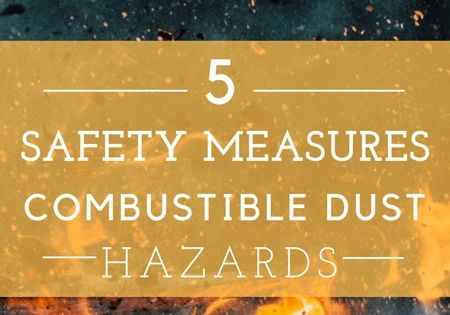
Combustible Dust in the Workplace
A combustible dust explosion at a plant can have catastrophic consequences for many workers, including loss of life. In fact, according to OSHA, over the last 28 years there have been approximately 3,500 combustible dust explosions. Roughly, 281 of the major incidents resulted in the deaths of 119 workers, with another 718 sustaining injuries.
What is Combustible Dust?
Combustible dust refers to any metallic or non-metallic airborne dust that is capable of causing a fire explosion. OSHA established that five elements must be present for a dust explosion to occur. The first three elements are needed for a fire to start. If the other two elements are present, then a combustible dust explosion will occur. If any one of these elements is missing, an explosion will not occur.
- Combustible dust (fuel)
- Ignition source (heat)
- Oxygen in air (oxidizer)
- Dispersion of dust particles
- Confinement of the dust cloud
The determining factor on whether or not industrial dust is combustible lies in its KST value. Basically, any reading above zero indicates a potential risk for an explosion.
Preventative Measures
Accumulating dust at a processing plant is unavoidable given the materials that are handled and the vast space of the work site. The explosive affinity of solid flammable materials creates combustible dust byproducts which further place processing plants at a high risk. However, there are several proactive steps you can implement to greatly reduce the danger of a combustible dust explosion. To help you implement leading safety measures at your work site, we will explore five guidelines for preventing dust explosions.
1. Know Which Dusts are Combustible
It’s helpful to be familiar with the type of materials you are working with that can create combustible dust. For example, if you work with plastic powders, metal, or food, then chances are that your facility is producing combustible dust. If you aren’t sure whether or not a dust in your plant is combustible, you need to do some research.
Start by reviewing OSHA’s Material Safety Data Sheet (MSDS) and researching the combustible properties of your bulk solid. Then, use OSHA’s fact sheet on combustible dust to determine whether your product fits into one of the following categories: agricultural products, dusts, carbonaceous dust, metal dusts, or plastic dusts. Uncovering this information will allow you to make the right equipment choices and employ the proper prevention methods.
2. Perform Regular and Thorough Cleaning
One of the most important steps in preventing dust explosions from happening is through cleaning. Dust explosions cannot happen if there is no dust to explode. To remove combustible dust from your work site, identify high-risk areas and clean in that zone and the area adjacent to production lines at regular intervals. Since dust is most likely to build up in hard-to-clean places, ensure that personnel are cleaning the hidden and obstructed areas of your facility. This includes cleaning ventilation ducts, suspended ceilings, the tops of pipes, and other hard-to-reach places.
3. Conduct Hazardous Dust Inspection and Control Program
In order to safeguard that combustible dust is being removed from your work site, establish a system for inspection and control. Additionally, have designated employees or managers regularly investigate high-risk areas for dust accumulation. If the dust is thick enough to see on surfaces, employees will need to step up their cleaning game.
4. Control Ignition Sources
As mentioned earlier, dust explosions require combustible dust and oxygen and need only be ignited by a heat source. The more you can limit or eliminate sources of ignition from hazardous areas, the less likely a dust explosion will occur. To minimize the risk of igniting a dust explosion, secure the machinery that is used in your facility and always monitor its operations. Reduce the risk of sparks from static electricity by grounding or bonding your equipment. It’s also a good idea to disperse “No Smoking” signs throughout the work site to discourage smoking.
5. Use Specialized Cleaning Supplies
Vacuums and other cleaning methods that aren’t industrial grade or equipped to handle heavy loads can become overheated and spark an ignition on their own. In order to avoid creating a new ignition source during your cleaning routines, use vacuums that are certified for fire prevention. To clean your work site with minimal risk of fire or explosion, it is critical that you do not use compressed air, fans, or brooms. These methods only help to disperse clouds of dust to other areas of the plant.
Each of the safety and cleaning measures mentioned above will reduce the likelihood of your work site experiencing a dust explosion. To take your plant’s safety to the next level, consider installing a dust explosion suppression system that can detect an explosion before it happens.
To learn more, visit our combustible dust training page and contact us for assistance in your facility.
